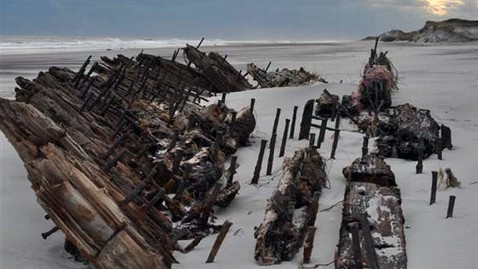Shipwreck Uncovered By Superstorm Sandy

The remains of a ship believed to have sank about 90 years ago has been uncovered by the near-hurricane force winds of Sandy.
The wreckage, believed to be a four-masted Canadian coal schooner named the Bessie White, has been fully exposed on New York's Fire Island.
"The ship's identity has not been confirmed," Paula Valentine, public affairs specialist at Fire Island National Seashore, told ABCNews.com. "But the old timers have told me that the remains are around where the Bessie White ran aground."
Bits of the ship's remains have peeped through the dunes many times over the decades after winter storms much smaller than Sandy, but until now no one knew the sand was hiding bus-size wreckage.
Cheryl Hapke, a United States Geological Survey researcher and barrier island expert based out of St. Petersburg, Fla., flew to New York prior to Sandy's landfall when it became clear the storm would have historic impact in order to study the barrier island.
Hapke said barrier islands like Fire Island naturally shift during storms, with dunes slowly inching toward the islands' centers.
"Sandy moved the dunes much further, over 70 feet from where they were before the storm. That's why we now see so much of the wreck," Hapke told ABCNews.com.
Fire Island was hit hard by Sandy and many estimates put the portion of the island underwater at the height of the storm at 50 percent, some places by as much as nine feet above mean sea level.
Neither Hapke nor Valentine are certain if the ship remains will ever be positively identified. However, both agree that Sandy's impact was unprecedented and the uncovering of this shipwreck is a fine example.
"It is really exciting," said Hapke, "I've never seen anything like this exposed before."